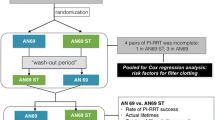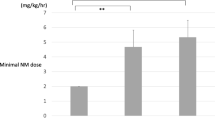Abstract
Purpose
The need for continuous anticoagulation remains a significant drawback in continuous renal replacement therapy (CRRT), especially in patients with increased bleeding risk. Polyethyleneimine treatment of the AN69 membrane (AN69ST) reduces thrombogenicity through decreased contact activation and promotion of heparin binding. The aim of this study is to evaluate whether this membrane prolongs filter survival in CRRT without anticoagulation.
Methods
A single-center, prospective, randomized, double-blind controlled trial with cross-over design comparing filter survival with the AN69ST membrane and the original AN69 membrane in 39 patients treated with continuous venovenous hemofiltraton (CVVH) without additional heparin.
Results
Filter survival with the AN69ST membrane (n = 75) was 14.2 ± 8.2 h, which is not significantly different from the 13.3 ± 10.3 h for the original AN69 membrane (n = 76; p = 0.59). Limiting the analysis to those treatments that were interrupted for filter clotting yielded similar results: 14.4 ± 8.2 h for the AN69 ST membrane (n = 62) versus 14.1 ± 7.5 h for the original AN69 membrane (n = 56) (p = 0.93).
Conclusions
Compared with the original AN69 membrane, the surface-treated AN69ST membrane does not prolong filter survival during CVVH without systemic anticoagulation and with the CRRT settings used in this study.




Similar content being viewed by others
References
Oudemans-van Straaten HM, Wester JP, de Pont AC, Schetz MR (2006) Anticoagulation strategies in continuous renal replacement therapy: can the choice be evidence based? Intensive Care Med 32:188–202
Oudemans-van Straaten HM (2010) Citrate anticoagulation for continuous renal replacement therapy in the critically ill. Blood Purif 29:191–196
Thomas M, Valette P, Mausset AL, Déjardin P (2000) High molecular weight kininogen adsorption on hemodialysis membranes: influence of pH and relationship with contact phase activation of blood plasma. influence of pre-treatment with poly(ethyleneimine). Int J Artif Organs 23:20–26
Chanard J, Lavaud S, Paris B, Toure F, Rieu P, Renaux JL, Thomas M (2005) Assessment of heparin binding to the AN69 ST hemodialysis membrane: I Preclinical studies. ASAIO J 51:342–347
Lavaud S, Paris B, Maheut H, Randoux C, Renaux JL, Rieu P, Canard J (2005) Assessment of the heparin-binding AN69 ST hemodialysis membrane: II. Clinical studies without heparin administration. ASAIO J 51:348–351
Evenepoel P, Dejagere T, Verhamme P, Claes K, Kuypers D, Bammens B, Vanrenterghem Y (2007) Heparin-coated polyacrylonitrile membrane versus regional citrate anticoagulation: a prospective randomized study of 2 anticoagulation strategies in patients at risk of bleeding. Am J Kidney Dis 49:642–649
Richtrova P, Rulcova K, Mares J, Reischig T (2010) Evaluation of three different methods to prevent dialyzer clotting without causing systemic anticoagulation effect. Artif Organs 35:83–88
Sagedal S, Witczak BJ, Osnes K, Hartmann A, Os I, Eikvar L, Klingenberg O, Brosstad F (2011) A heparin-coated dialysis filter (AN69 ST) does not reduce clotting during hemodialysis when compared to a conventional polysulfone filter (F × 8). Blood Purif 32:151–155
Brunet Ph, Frances J, Vacher-Coponat H, Jaubert D, Lebrun G, Gondouin B, Duval A, Berland Y (2011) Hemodialysis without heparin: a randomized, controlled, crossover study of two dialysis membranes (AN69ST and polysulfone F60). Int J Artif Organs 34:1165–1171
Burry LD, Tung DD, Hallett D, Bailie T, Carvalhana V, Lee D, Ramganesh S, Richardson R, Mehta S, Lapinsky SE (2009) Regional Citrate Anticoagulation for PrismaFlex Continuous Renal Replacement Therapy. Annals Pharmacother 43:1419–1425 (abstract)
Xie W, Heidenreich S, Abbas S, Mann H (2009) Alteration of membrane properties in hemofilters during continuous hemofiltration (CVVH). ASAIO J 55:178 (abstract)
Xie WH, Heidenreich S, Vienken J, Mann H (2010) Shear stress in the hollow fibers and protein permeability during continuous hemofiltration. Int J Artif Organs 33:443 (abstract)
Kleger GR, Fässler E (2010) Can circuit lifetime be a quality indicator in continuous renal replacement therapy in the critically ill? Int J Artif Organs 33:139–146
Lavaud S, Canivet E, Wuillai A, Maheut H, Randoux C, Bonnet JM, Renaux JL, Chanard J (2003) Optimal anticoagulation strategy in haemodialysis with heparin-coated polyacrylonitrile membrane. Nephrol Dial Transpl 18:2097–2104
Chanard J, Lavaud S, Maheut H, Kazes I, Vitry F, Rieu P (2008) The clinical evaluation of low-dose heparin in haemodialysis: a prospective study using the heparin-coated AN69 ST membrane. Nephrol Dial Transpl 23:2003–2009
Kappelmayer J, Bernabei A, Edmunds LH Jr, Edgington TS, Colman RW (1993) Tissue factor is expressed on monocytes during simulated extracorporeal circulation. Circ Res 72:1075–1081
Tabuchi N, Shibamiya A, Koyama T, Fukuda T, Oeveren Wv W, Sunamori M (2003) Activated leukocytes adsorbed on the surface of an extracorporeal circuit. Artif Organs 27:591–594
Keuren JF, Wielders SJ, Willems GM, Morra M, Lindhout T (2002) Fibrinogen adsorption, platelet adhesion and thrombin generation at heparinized surfaces exposed to flowing blood. Thromb Haemost 87:742–747
Zemanova P, Opatmy K, Vit L, Sefma F (2005) Tissue factor, its inhibitor, and the thrombogenicity of two new synthetic membranes. Artif Organs 29:651–657
Barstad RM, Hamers MJ, Møller AS, Sakariassen KS (1998) Monocyte procoagulant activity induced by adherence to an artificial surface is reduced by end-point immobilized heparin-coating of the surface. Thromb Haemost 79:302–305
Semeraro F, Ammollo CT, Semeraro N, Colucci M (2009) Tissue factor-expressing monocytes inhibit fibrinolysis through a TAFI-mediated mechanism, and make clots resistant to heparins. Haematologica 94:819–826
Levi M, van der Poll T, ten Cate H (2006) Tissue factor in infection and severe inflammation. Semin Thromb Hemost 32:33–39
Osterud B (1998) Tissue factor expression by monocytes: regulation and pathophysiological roles. Blood Coagul Fibrinolysis 9(Suppl 1):S9–S14
Joannidis M, Oudemans-van Straaten HM (2007) Clinical review: patency of the circuit in continuous renal replacement therapy. Crit Care 11:218
Young E, Prins M, Levine MN, Hirsh J (1992) Heparin binding to plasma proteins, an important mechanism for heparin resistance. Thromb Haemost 67:639–643
Young E, Podor TJ, Venner T, Hirsh J (1997) Induction of the acute-phase reaction increases heparin-binding proteins in plasma. Arterioscler Thromb Vasc Biol 17:1568–1574
Conflicts of interest
The authors report no conflict of interest.
Author information
Authors and Affiliations
Corresponding author
Rights and permissions
About this article
Cite this article
Schetz, M., Van Cromphaut, S., Dubois, J. et al. Does the surface-treated AN69 membrane prolong filter survival in CRRT without anticoagulation?. Intensive Care Med 38, 1818–1825 (2012). https://doi.org/10.1007/s00134-012-2633-x
Received:
Accepted:
Published:
Issue Date:
DOI: https://doi.org/10.1007/s00134-012-2633-x




